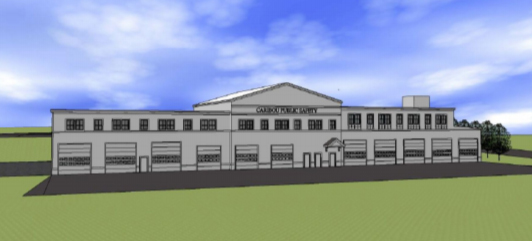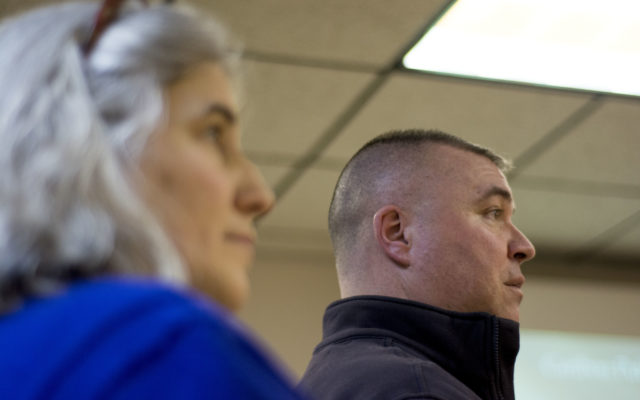
CARIBOU, Maine — Caribou City Council voted to move forward with a $25,000 study to determine the feasibility of constructing a public safety building at the former Birdseye property on the corner of Route 1 and Fort Street.
According to Fire Chief Scott Susi and Mayor David Martin, money for the study is already included in this year’s budget. The complex, which is estimated to cost roughly $8 million, will house the city’s police, fire, and ambulance departments under one roof.
Susi and Police Chief Michael Gahagan spoke to council about the deteriorating condition of their respective facilities and how a new, consolidated building could help their organizations as well as the city.
The fire and ambulance building’s current “conditions are very cramped for the amount of people working there,” said Susi. “We only have one bathroom in the facility, and it’s not set up for public use,” Susi said. “So when [members of the community] are doing car washes or fundraisers at the station, there is no bathroom for them to use.”
He added that the station’s sole bathroom is not set up for multiple gender use, preventing the department from hiring women.
The High Street fire station was built in 1977 and, according to Susi, the department has gone beyond its capacity for expansion. Floors are buckling under crowded emergency vehicles, and with the department handling an average of “7.8 calls per day,” the garage doors are constantly opening and closing, causing the building to lose heat.
Susi says he has had to purchase “equipment to fit the building” instead of “equipment to fit the need.”
Gahagan said the police station, located on the first floor of the Caribou Municipal building, also suffers from a lack of space. Though it is the only facility north of Houlton equipped to hold prisoners, the station is “just too small” to contain jail cells in addition to all of the other necessary equipment.
“Computers are supposed to make everything easier,” Gahagan said, “but they actually caused us to lose space. Our kitchen is now a room full of computers.”
He added that, since police departments are required to hold onto evidence, much of their evidence is stored at another location.
The winter months are also hard on the station, and Gahagan said their three-bay garage was only 57 degrees during the past weekend.
“We have to keep our public bathroom doors open so the pipes don’t freeze,” he said. “We do the best with what have, but unfortunately it’s not good enough for the City of Caribou and it’s not good enough for our citizens.”
The chiefs have been working with Port City Architecture of Portland on plans for the new building. Lita Semrau, Principal NCARB, LEED-AP with Port City Architecture, showed councilors conceptual computer-generated sketches of the new building during a Jan. 8 meeting.
Semrau said the new building would include a sally port, a secure area where police can transfer prisoners, which is “strongly recommended.” The middle of the facility would include a public area with a meeting/training room, public bathrooms, a gym and a front entrance area. Police would be situated on the left side of this area, with fire and ambulance on the right.
In addition to the sally port, the police department would include two garages, a booking area, patrol room, five holding cells, multiple bathrooms and interview rooms, an armory, three rooms for evidence storage, a break room, male and female locker rooms, and several offices for staff on the top floor.
The fire department would utilize both the right side of the top floor and much of the bottom floor, and would have several administrative offices, two public bathrooms, 23 bunks, a library, a day room with a television, a kitchen and dining room, and a pole and elevator leading to the bottom floor, which would consist primarily of bays for emergency vehicles.
Semrau said the use of separate bays for the ambulances and other emergency vehicles will keep the building and fire trucks from getting cold as doors open and close.
Mayor Martin asked about the possibility of building a shooting range in the basement, adding officers “can’t practice for six months out of the year, and when they do end up practicing, people don’t like it because of the noise.”
Semrau said once budget details are established, she can determine the cost of including a shooting range.
Councilor Hugh Kirkpatrick asked if any alternatives were considered, and if it would be feasible to renovate the current fire department.
Semrau said both departments have significant structural issues and that renovation would be constrained by the land on the current site. In order to meet American Disability Act standards, the city would have to acquire more land for the fire department in addition to addressing insulation issues in the facility’s roof, as well as adding sprinklers and an alarm system.
“That laundry list of issues tells me that many thousands of towns all over the country are going to have to build new fire stations,” Kirkpatrick said.
- Lita Semrau, Principal NCARB, LEED-AP with Port City Architecture, and Caribou Fire Chief Scott Susi discussed conceptual plans for a new public safety facility, which would combine they city’s Fire, Ambulance, and Police departments into one building, during a Jan. 8 City Council (Christopher Bouchard)
Semrau confirmed there are about 20 at various stages in Maine. “A lot of this is driven by the fact that fire trucks have gotten a lot heavier over the past 20 to 30 years,” she said, because they hold more water.
The current price estimate is $8 million, Semrau said, but there is a possibility that the city could obtain a rural development grant to cover 55 percent of the costs.
Councilor Joan Theriault added that there are significant issues with the police station and no available grants for the police to build a new facility, and that this grant money could be used to improve both facilities by putting them together.
Susi estimated that with the grant, doing a 20- to 30-year bond for the remainder and adding in school consolidation savings, “What’s left is almost a wash to taxpayers.”
“It’s rough,” he said, “but off the rough numbers of what the building will cost, what we can get for grant funding, and what the school said they can save, the price should be down there.”
City Manager Dennis Marker said the $25,000 study will help the city determine an actual dollar amount for the project, at which point it would go out to public vote.
Councilor Mark Goughan questioned the location as well as the possibility of collaborating with neighboring communities for public safety needs.
Susi said the motivating factor for choosing the site was that it’s already owned by the city, so would cost nothing to acquire. He added it provides easy access to neighboring towns (that do not have public safety departments) as well as to the center of Caribou.
Semrau said pooling safety resources is not possible, as each community needs to have a police and fire department within a certain radius.
“You want to make sure that an ambulance doesn’t take 40 minutes to get to you if you’re having a heart attack,” she said. “You want to make sure it doesn’t take 30 minutes for the police to respond to a domestic violence incident. Each community needs their own [departments].”
Goughan said he respectfully disagrees, adding there is “just so much unknown here.”
Theriault suggested moving forward with the study, and said many of these questions will likely be answered after it is complete.
Before councilors voted in favor of the study, the Mayor added that a simultaneous study on the Birdseye site will be conducted, allowing council to determine the best use of that site as well.








